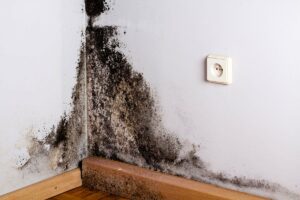Mold can be difficult to track in a home. Mold involves fungi that feed on cellulose, often found in clay-based paints, carpeting, or fabrics, and when there is too much moisture, mold can begin to grow. Mold spores are typically microscopic so the only way to actually see them is by using magnification devices such as microscopes.
Mold can cause health problems for humans if they inhale it. Molds also have the ability to release mycotoxins that may impact human respiratory systems as well as immune system functions. In extreme situations, molds could even potentially kill someone with a weak immune system. There are multiple types of molds identified by color and those include:
 GREEN MOLD – This mildew is found in greenish-black colonies and is considered the smallest of all molds. This particular type of mold is visible to the naked eye and can be very harmful if inhaled.
GREEN MOLD – This mildew is found in greenish-black colonies and is considered the smallest of all molds. This particular type of mold is visible to the naked eye and can be very harmful if inhaled.
WHITE MOLD – Mold from this category is typically white or gray in color with a cottony appearance, due to the fact that these molds create spores. In most cases, people do not have to worry about white mold unless they are highly sensitive to it due to allergies.
BLACK MOLD – Mold that comes from this color group requires immediate attention because it can cause serious health problems. This type usually only affects people who suffer from debilitating health conditions such as cancer, AIDS, or lung disease.
BROWN MOLD – Mold in this category can be identified by a musty or earthy smell and is only visible to the human eye when viewed under magnification.
RED MOLD – Mold from this color group may appear pink, brown, orange, or even purple. This type of mold is typically found in the same areas as the green variety and makes people sick more often than any other color group.
 It’s possible for homeowners to have molds growing on their property without even realizing it due to not being able to see them with their own eyes. It’s also possible for these molds to be hidden behind walls, inside walls, or underneath floors if there are leaks happening that are causing water damage. Mold can grow anywhere that has excess humidity so it is safe to assume that there is a possibility of having mold in every home to some degree. Mold can be seen growing on almost any surface, from wood to wallpaper and from the ceiling down to the carpeting. Mold issues should always be taken seriously by homeowners because they can cause serious health concerns for residents, including respiratory problems or other allergy-related reactions.
It’s possible for homeowners to have molds growing on their property without even realizing it due to not being able to see them with their own eyes. It’s also possible for these molds to be hidden behind walls, inside walls, or underneath floors if there are leaks happening that are causing water damage. Mold can grow anywhere that has excess humidity so it is safe to assume that there is a possibility of having mold in every home to some degree. Mold can be seen growing on almost any surface, from wood to wallpaper and from the ceiling down to the carpeting. Mold issues should always be taken seriously by homeowners because they can cause serious health concerns for residents, including respiratory problems or other allergy-related reactions.
In cases where there may be significant mold growth within a building or possibly even throughout an entire property, it’s important that the affected areas are dealt with in a thorough manner, which includes professionals running testing in order to determine if indoor air quality has been compromised. Mold spores will actually continue to grow until the moisture problem is solved so it’s very difficult for this issue to resolve itself without help from an expert. Mold testing and inspection should be done by a professional to get an accurate idea of the extent of the problem as well as to see if any kind of remediation is necessary. It’s important to keep in mind that not all molds are harmful, but it’s always better to be safe than sorry when it comes to the health and well-being of loved ones.
Schedule an appointment at (720) 902-7040.


